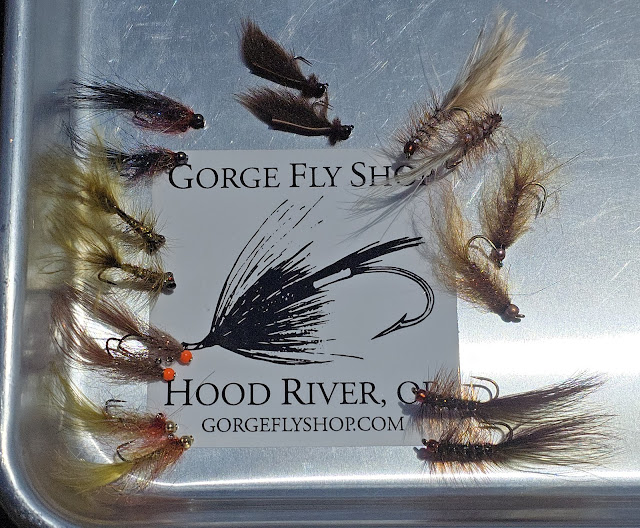If I name off a species do you automatically think about the weight fly rod you would employ! Did you consider location factors, expected wind conditions, fly size, expected cast distance and last but certainly not least, your skill level? What if we match rod size to the situation in which we intend to use it?
Situational Casting
I have a good friend that is a guide and when I fish with him he will put me in casting situations way outside of my comfort zone. Just like a golf pro consulting his caddie, we will talk about the many factors that can effect the given cast and what to do to overcome and succeed. We often refer to it as situational casting. Just like in golf, every situation has it's own set of difficulties and each must be considered carefully.What direction is the wind, strong shoulder or off shoulder casting, back cast space and distance to target are just the usual situations most often encountered. Then also fly size, importance of presentation quality and target size. A given situation might also include lead time, sink rate, mend requirements and/or current effects.
Many of you may know that I am a bit fanatical about bass fly angling, both smallmouth and largemouth bass. For this reason I will use bass fly fishing as my example species and how I will decide what weight fly rod to use. Keep in mind though if you are a frequent chaser of brown trout with streamers and large dries most these same principals of rod sizing still apply.
Fly Rod Weights
5 weight
I rarely will use a 5 weight or anything less for bass.Unless your watershed is just full of dinks I can find no reason to fish a 5 weight or less. Let's say for sake of argument, small fish size and small fly size gives one no reason to fish bigger, I'd still at least be trying to find the adult fish. Even if a 5 weight is enough, take a 6 weight instead. If nothing else it will let you increase your fly size and provide more butt to overcome wind and structural obstacles.
 |
| This 19" smallie was landed on a 6 weight and he had it corked! |
6 weight
Average smallmouth and average fly size, a 6 weight rod may be the only rod you'll ever need yet I rarely ever employ a 6 weight. Same reasons as avoiding the 5 weights, I'm seeking larger fish and casting larger flies to attract them. Most situations a 6 weight is good but...7 weight
If I had to have one rod...need I say any more!Today's 7 weights are so versatile. Whether it be bass, browns, bones and and let's not forget carp. Everyone needs a seven weight.
 |
| Most anglers think an 8 weight is overkill for bass fishing. I have differing opinions about that subject |
8 weight
Is an 8 weight overkill? Put yourself in a boat on a large bass fishery. Now add some wind. Average fly size is 5-6 inch streamers and you're fishing a sinking tip fly line. Now I'll remind you that this is not sight fishing, instead it's repeated, precision cast after cast to shoreline structure.While it can take more effort to cast a larger rod, a larger rod can make easier work of hard situational casting.
I realize this is pushing into the extremes but isn't that what hard core fly anglers do today. That's what I'm doing! If you want to chase that unicorn...!!!
 |
| 20" Smallie on the Sage Bass Largemouth 330gr Fly Rod |
Bigger than 8 weight - Now you know I've lost my marbles!
I don't go buy rods bigger than 8 weight for the purpose of predator hunting but...One of my most successful rods in my quiver is a Sage Bass Largemouth rated for 330 grain line.
If you look up 330gr on the AFFTA approved fly line weight specifications this would fall into an 11 weight rod specs. Fact is this scale just doesn't work for this rod. I would go farther and say this scale doesn't work for any modern rod but that starts a trip down a dead end road with no way to turn around.
Even though this bass rod has a high line rating it doesn't feel any different than any modern 8 weight. Couple this rod with a stout WF8F line like the RIO InTouch Outbound Short or Scientific Anglers Amplitude Titan Long and it will prove to you what an accurate, big fly champion it is.
This rod gets used for heavy cover, heavy tippet, ambush fishing situations involving the thickest, nastiest cover I can find. There's rarely a reward without getting risky! This is 20lb tippet zone. The fly is coming home with or without a bass.
Set the Hook Already
When you do hook that trophy, you want to be sure you've got the muscle to pull him from the jungle he calls home. Chances are it won't be his first rodeo and if you give him a nano second he will most likely defeat you. Get him to open water and you'll gain the upper hand.In these examples, matching rod to situation rather than species, we can fish more effectively. Our cast will be more efficient. Our versatility will increase which in turn can create more opportunities.
My whole point to this article is to help us become aware that choosing a rod weight has as much to do with situations as it does the species we pursue. Match it to the given situation and success can greatly improve.
Greg
Note the title, "Predator Hunt". This article is the first to be named Predator Hunt and is a continuation of my series of articles called "On the Hunt"
 |
| I'll see you on the water...But you won't see me! Follow me @greg.darling.angler |
Greg Darling
























No comments :
Post a Comment